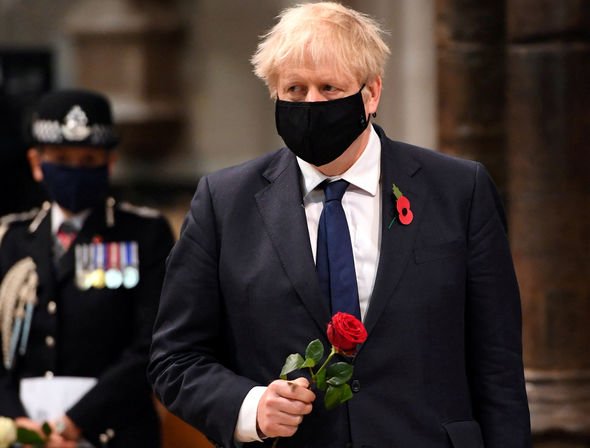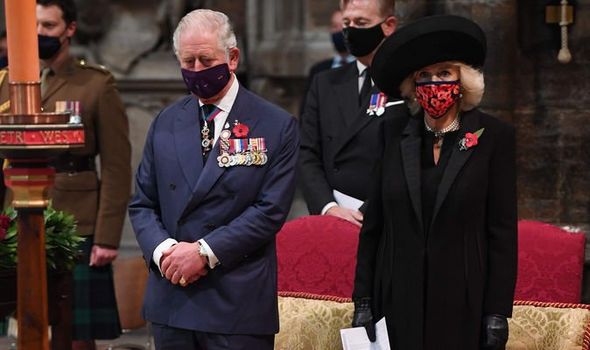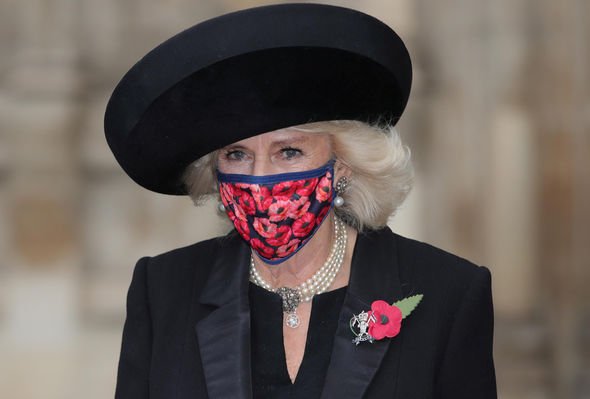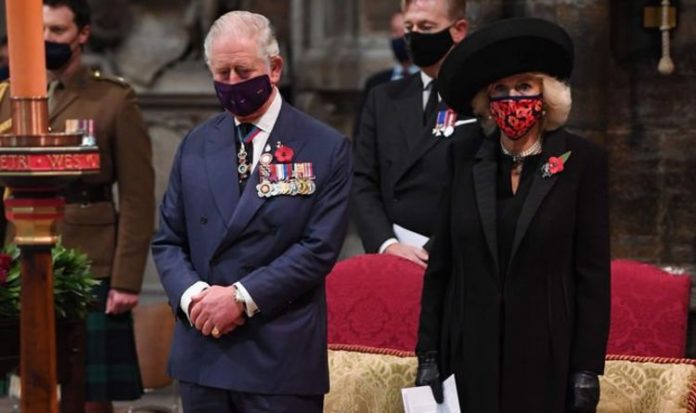The royal couple donned face masks to join a congregation restricted to 80 people because of coronavirus rules. But millions across Britain observed the two-minute silence for the fallen. Socially distanced commemorations were held across the country as young and old honoured the dead. More than 2,200 people had been due to attend the Westminster Abbey service, but the plans were changed because of Covid-19. However, the Abbey received Government permission to hold the event beside the grave of the Unknown Warrior. The site has become a place of pilgrimage for those whose loved ones have made the ultimate sacrifice, but whose graves are unknown.

The congregation included Boris Johnson (Image: Reuters )
The warrior was taken from the Western Front to be buried among the kings in the Abbey on Armistice Day 1920.
Charles laid a wreath of red roses and bay leaves. It was a replica of the floral tribute left by his great-grandfather, George V, on that day. The Prince also gave a Bible reading.
Camilla, whose father Major Bruce Shand twice won the Military Cross before being captured at El Alamein in the Second World War, left a posy of red roses and greenery.
She wore a black crepe dress and coat, a British Legion poppy mask, a Philip Treacy hat, and the regimental brooch of her father’s cavalry unit, the 9th/12th Royal Lancers.
The congregation included Prime Minister Boris Johnson, Labour leader Sir Keir Starmer, Defence Secretary Ben Wallace and leading figures from the Armed Forces.

Prince Charles and the Duchess Of Cornwall led the nation in a service at Westminster Abbey (Image: PA)
The Archbishop of Canterbury Justin Welby told the socially distanced gathering: “Sacrifice is not only in time of war.
“In war and peace sacrifice is the virtue that smooths the rough roads over which our societies travel.
“This year sacrifices have been made and are being made by thousands, even millions, unknown. People have put aside all they hold dear. We may never meet them or read their names. They may be anonymous, but their actions are glorious.
“The Unknown Warrior sounds the call of sacrifice for every person.”
The Unknown Warrior grave was created at Westminster Abbey following a campaign by the Reverend David Railton, who served as a chaplain on the Western Front during the First World War.
The body was chosen from four unknown British servicemen, exhumed from four battle areas in France and Flanders, by Brigadier General Louis Wyatt, commander of British forces on the front, and transported back to Britain.
On November 11, 1920, the coffin was draped with a Union flag and taken on a gun carriage to the Cenotaph.
George V placed a wreath upon it and the warrior was buried at the Abbey.
The Archbishop added: “On this centenary of the burial of the Unknown Warrior at Westminster Abbey we pay tribute to the many millions of men and women who have died on so many battlefields, unnamed and unclaimed, except by God.” Poet laureate Simon Armitage read his poem The Bed, written to commemorate the centenary.
Colour Sergeant Johnson Beharry, who was awarded the Victoria Cross for twice saving colleagues under fire in Iraq, also took part in the service.
Elsewhere, many observed the traditional silence at 11am from home because of widespread restrictions on travel and gatherings.
Medal-wearing veterans stood on their doorsteps or beside local war memorials to join in the collective acts of remembrance. In Liverpool, soldiers paused their work helping with mass Covid testing in the city.
At London’s King’s Cross station, travellers observed the silence beneath a giant poppy installation.
The Earl and Countess of Wessex laid wreaths during an Armistice Day service at the National Memorial Arboretum in Staffordshire.
At Blenheim Palace, in Oxfordshire, people paused among 200 silhouettes of soldiers created by artist Dan Barton.

The Duchess of Cornwall donned a face mask to join the congregation (Image: Reuters)
Scotland’s First Minister Nicola Sturgeon observed the two-minute silence at St Andrew’s House in Edinburgh alongside service personnel from the Navy, Army and
the RAF.
She said the sacrifice of those who “helped to secure the freedoms we enjoy today” must never be forgotten.
In Royal Wootton Bassett, the Wiltshire town known for the military funeral repatriations that passed through its centre, the Last Post was played near a war memorial.
In Gateshead, the Angel of the North statue was given its own poppy to mark the day.
And cities across the country lit up buildings in red to mark the commemorations.







